By: Michael DeGrandpre, University of Montana-Missoula; Wiley Evans, Hakai Institute; Mary-Louise Timmermans, Yale University; Richard Krishfield, Woods Hole Oceanographic Institution; Bill Williams, Institute of Ocean Sciences; and Michael Steele, University of Washington
Anthropogenic emissions have increased atmospheric carbon dioxide (CO2) from ~290 to 410 ppm over the past 100 years leading to levels that are higher on average than the surface ocean. Because of this disequilibrium, the oceans take up a significant fraction (~25%) of the anthropogenic CO2, reducing the greenhouse impact of human emissions while simultaneously, in a classic "no free lunch" scenario, being altered by ocean acidification. The Arctic Ocean is unique in that air-sea exchange of CO2 has been limited in the past because of extensive, perennial ice cover. But recent loss of ice, with seasonal levels as low as 50% ice extent, compared to the beginning of the satellite record (1979), has opened the Arctic Ocean to direct exchange of CO2 with the atmosphere. Past studies of the Arctic Ocean have found that dissolved CO2, reported as the partial pressure of CO2 (pCO2), is typically lower than atmospheric levels; therefore, loss of sea ice has likely increased the global uptake of atmospheric CO2. It is hypothesized that this beneficial side-effect could come at the cost of increasing sea surface pCO2 levels, resulting in reduced air-sea uptake over time, while also accelerating ocean acidification in the region. The response of the carbon cycle to the changing physical conditions of the Arctic Ocean is complex and not readily predicted, however. Sea surface pCO2 variability in the Arctic Ocean is intertwined with biological production, ice formation, and melting (where CO2 is concentrated or diluted, respectively), heating and other processes, all of which are no longer in steady state. Sparse long-term data have limited our ability to assess variability of sea surface pCO2 that is related to these changes.
We have been measuring pCO2 in the Canada Basin of the Arctic Ocean since 2012 to help address this shortcoming. Cruises have taken place on the Canadian icebreaker, the CCGS Louis S. St-Laurent as part of the Beaufort Gyre Observing System and Joint Ocean Ice Study (BGOS/JOIS) programs through Woods Hole Oceanographic Institution (Woods Hole, Massachusetts) and the Institute of Ocean Sciences (Sidney, British Columbia), respectively. These cruises, conducted since 2002 with support from NSF, have focused on the hydrography and biogeochemistry of the western Arctic Ocean. The cruises offer a golden opportunity to help understand the Arctic Ocean carbon cycle by repeatedly visiting one of the Arctic's deep ocean basins, following roughly the same cruise track from year to year (Figure 1). Our role, in addition to deploying CO2 and pH sensors on moorings and Ice-Tethered Profilers (Islam et al. 2017; DeGrandpre et al. 2019), has been to measure sea surface pCO2 using an infrared-equilibrator based system connected to the ship's seawater line (Figure 3).
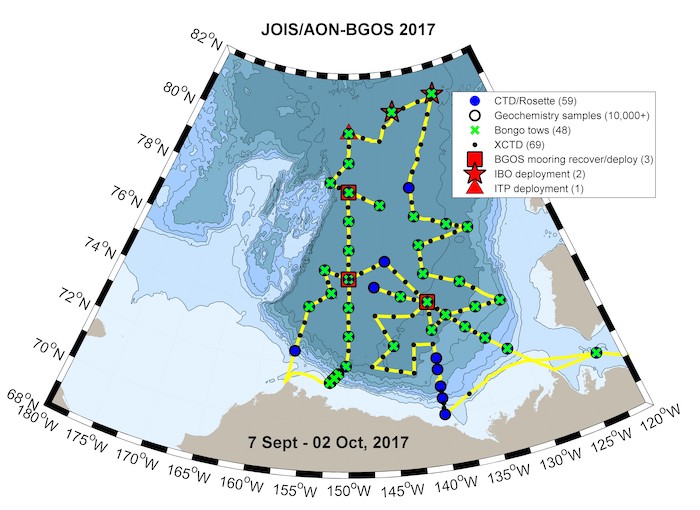
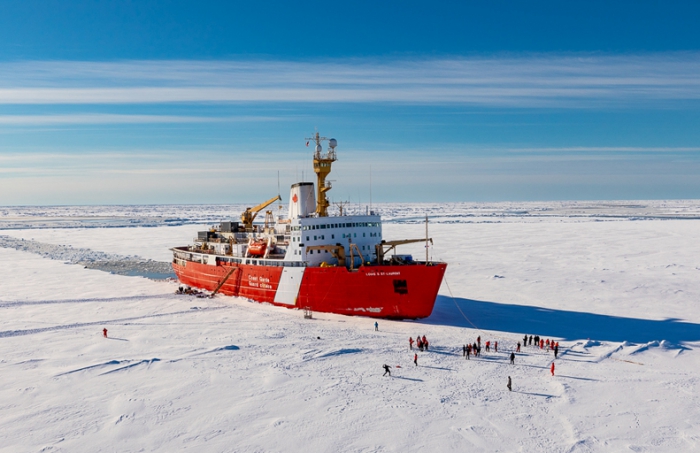
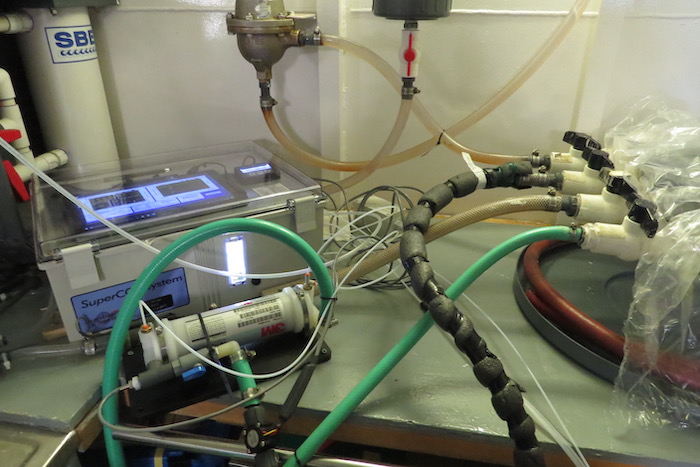
The data that we have collected, spanning 2012 to 2017, show that sea surface pCO2 in the Canada Basin is significantly higher during years when ice cover is low (DeGrandpre et al. 2020). Based on simple model estimates, the higher levels are driven by uptake of atmospheric CO2 and heating with only a small counteracting offset from biological production. These processes vary significantly from year to year due to variable periods of open water and winds that regulate gas exchange rates and, to some extent, mixed layer depths. This interannual variability hides any net increase in sea surface pCO2 that could occur from year to year. However, our data combined with historical data in the same region shows that pCO2 in the Canada Basin has increased at twice the rate of atmospheric CO2 (Ouyang et al. 2020). Based on these observations, we can expect that while the Arctic Ocean has been a significant sink for atmospheric CO2 (up to ~10% of the annual global uptake, Yasunaka et al. 2018), this will diminish in the coming years if ice loss continues. Although ocean acidification was not a focus of this analysis, the loss of ice has rapidly accelerated its pace, which could have important ecological consequences for marine organisms. The NSF Arctic Observing Network program is supporting continuation of our project through 2023 making it possible to observe these expected changes in the Arctic Ocean carbon cycle in the coming years.
References
DeGrandpre, M., Evans, W., Timmermans, M.‐L., Krishfield, R., Williams, B., and M. Steele. 2020. Changes in the Arctic Ocean carbon cycle with diminishing ice cover. Geophys. Res. Letters, 47, http://dx.doi.org/10.1029/2020GL088051.
DeGrandpre, M. D., Lai, C.‐Z., Timmermans, M.‐L., Krishfield, R. A., Proshutinsky, A., and Torres, D. 2019. Inorganic carbon and pCO2 variability during ice formation in the Beaufort Gyre of the Canada Basin. J. Geophys. Res. – Oceans. 124: 4017–4028, https://doi.org/10.1029/2019JC015109.
Islam, F., DeGrandpre, M., Beatty, C., Timmermans, M.-L., Krishfield, R., Toole, J. and S. Laney. 2017. Sea surface pCO2 and O2 dynamics in the partially ice-covered Arctic Ocean. J. Geophys. Res. – Oceans. 122. doi:10.1002/2016JC012162.
Ouyang, Z., Qi, D., Chen L., Zhong, W., Takahashi, T., DeGrandpre, M.D., Chen, B., Gao, Z., Nishino, S., Murata, A., Sun, H., Robbins, L.L., Jin, M., and W.-J. Cai. 2020. Sea-ice loss amplifies summer-time decadal CO2 increase in the western Arctic Ocean, Nature Climate Change, https://doi.org/10.1038/s41558-020-0784-2.
Yasunaka, S., Siswanto, E., Olsen, A., Hoppema, M., Watanabe, E., Fransson, A., et al. 2018. Arctic Ocean CO2 uptake: An improved multiyear estimate of the air–sea CO2 flux incorporating chlorophyll a concentrations. Biogeosciences 15: 1643–1661. https://doi.org/10.5194/bg-15-1643-2018.
About the Authors
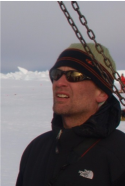 Mike DeGrandpre is a professor in the Department of Chemistry and Biochemistry at the University of Montana. His interests are focused on the development and application of autonomous sensors for studying the carbon cycle in ocean and freshwater ecosystems. He is a relative newcomer to Arctic research having only been studying the Arctic for the past nine years.
Mike DeGrandpre is a professor in the Department of Chemistry and Biochemistry at the University of Montana. His interests are focused on the development and application of autonomous sensors for studying the carbon cycle in ocean and freshwater ecosystems. He is a relative newcomer to Arctic research having only been studying the Arctic for the past nine years.
 Wiley Evans is a research scientist at the Hakai Institute in British Columbia, Canada. His research focuses on net exchanges of carbon dioxide between surface waters and the atmosphere, manifestations of ocean and estuarine acidification, and the drivers of variability in marine carbonate chemistry.
Wiley Evans is a research scientist at the Hakai Institute in British Columbia, Canada. His research focuses on net exchanges of carbon dioxide between surface waters and the atmosphere, manifestations of ocean and estuarine acidification, and the drivers of variability in marine carbonate chemistry.
 Mary-Louise Timmermans is the Damon Wells Professor of Earth and Planetary Sciences at Yale University. She is a physical oceanographer who explores the relationship between Arctic Ocean circulation and climate, and a Co-PI of the NSF Arctic Observing Network program, the Beaufort Gyre Observing System.
Mary-Louise Timmermans is the Damon Wells Professor of Earth and Planetary Sciences at Yale University. She is a physical oceanographer who explores the relationship between Arctic Ocean circulation and climate, and a Co-PI of the NSF Arctic Observing Network program, the Beaufort Gyre Observing System.
 Rick Krishfield is a Senior Research Specialist in the Department of Physical Oceanography at the Woods Hole Oceanographic Institution. His research interests include polar oceanography and biogeochemistry; air-ice-ocean interactions; under-ice submesoscale coherent vortices; and ice floe dynamics, kinematics, and thermodynamics.
Rick Krishfield is a Senior Research Specialist in the Department of Physical Oceanography at the Woods Hole Oceanographic Institution. His research interests include polar oceanography and biogeochemistry; air-ice-ocean interactions; under-ice submesoscale coherent vortices; and ice floe dynamics, kinematics, and thermodynamics.
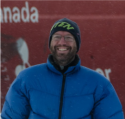 Bill Williams is a research scientist and physical oceanographer at the Institute of Ocean Sciences who has led multidisciplinary programs in the Beaufort Sea. He is the principal investigator of the Canada Basin JOIS program and chief scientist aboard the Louis S. St-Laurent during the BGOS/JOIS cruises. Among his interests are the study of shelf-break processes.
Bill Williams is a research scientist and physical oceanographer at the Institute of Ocean Sciences who has led multidisciplinary programs in the Beaufort Sea. He is the principal investigator of the Canada Basin JOIS program and chief scientist aboard the Louis S. St-Laurent during the BGOS/JOIS cruises. Among his interests are the study of shelf-break processes.
 Mike Steele is a Senior Principal Oceanographer in the Applied Physics Laboratory at the University of Washington. He is interested in the large-scale circulation of sea ice and water in the Arctic Ocean. He uses observations collected by in situ sensors and by satellites, as well as numerical model simulations to investigate time and space variations in sea ice and ocean properties.
Mike Steele is a Senior Principal Oceanographer in the Applied Physics Laboratory at the University of Washington. He is interested in the large-scale circulation of sea ice and water in the Arctic Ocean. He uses observations collected by in situ sensors and by satellites, as well as numerical model simulations to investigate time and space variations in sea ice and ocean properties.
